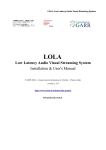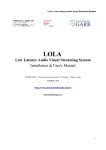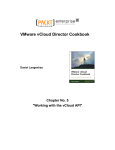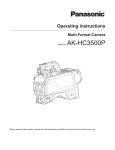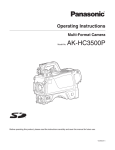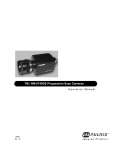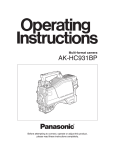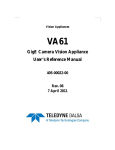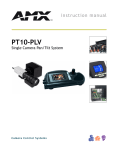Download LOLA Low Latency Audio Visual Streaming System
Transcript
LOLA: Low Latency Audio Visual Streaming System LOLA Low Latency Audio Visual Streaming System Installation & User's Manual © 2005-2012 - Conservatorio di musica G. Tartini – Trieste, Italy version 1.1.7 http://www.conts.it/artistica/lola-project lola-project@conts.it LOLA: Low Latency Audio Visual Streaming System 1. Introduction Lola is an Audio Visual Streaming System developed by “Conservatorio di Musica G. Tartini”, Trieste, Italy, with the goal to provide a tool for real-time audio video “natural” distance human interaction. It was originally conceived for distance music performances, education and production, but can be used for any other scenario where real-time interaction is required. A special attention has been paid to the optimization of the signal processing and transmission in order to keep the system latency as low as possible, below the human delay perception threshold. The system is based on high performance audio/video acquisition hardware, and on the integration and optimization of audio/video stream acquisition, presentation and transmission. The LOLA system also requires very high performance Wide Area and Local Area Networks: 1 Gigabit per second end-to-end connection is the minimum suggested configuration. 2. Hardware and Operating System prerequisites In order to achieve a low transmission and presentation latency, LOLA relies on software optimization and on high performance audio and video devices. Low latency video in particular has been achieved by adopting a family of industrial video grabbers which at the moment are only supported under the MS Windows Operating System. To date, LOLA has been tested on both MS Windows XP and MS Windows 7 (32 bits and 64 bits versions). 2.1. Audio input/output hardware requirements Low latency audio performance requires that small in/out audio buffers can be used, that no bottlenecks are present in the data transfer between the converters and the system, and that robust and efficient software drivers are available for the OS in use. USB and FireWire (IEEE 1394) external devices do not offer such a fast data acquisition processing, thus LOLA uses a PCI/PCIe internal device, and a reliable ASIO driver. To date, the following Audio boards have been tested and have shown good performances: – RME Hammerfal HDSP 9632 (PCI internal card) – RME Multiface II (PCI/PCIe host card + external ADC/DAC box) 2.2. Video input hardware requirements Fast video acquisition and streaming relies on a family of video grabbers by BitFlow Inc., which provides high hardware performances and a versatile programming API for low-level video processing control. The BitFlow video grabbers currently used by LOLA are the analog ones, like the – Bit Flow ALT AN1 grabber with SDK 5.60 drivers LOLA: Low Latency Audio Visual Streaming System which supports both analog b/w and color cameras. A possible camera for LOLA for b/w service is the – Sony HR50 b/w analog. In case of color video acquisition the video camera must provide component analog color output (RGB or YpbPr). For color operation the PC running LOLA should provide enough CPU power to deal with data processing, i.e., an i5/i7 CPU based workstation is recommended. The following color camera has been extensively tested with LOLA (and a camera file is provided): – Hitachi KP-FD30 color analog. To connect the cameras to the video grabber you need appropriate analog cables. Analog cables length can vary, and up to now cables up to 12m have been successfully used. Longer cables should work fine as well, but testing that the performance does not degrade is recommended. These cables can be easily created starting from high quality VGA cables, both for b/w and color analog cameras. A schematic of the cable pinout is included in Appendix C. LOLA also experimentally supports digital Camera Link grabber and cameras (B/W and Color), See Appendix A for details. See also Appendix B for further considerations and a short list of compatible video cameras. 2.3. Video output hardware requirements LCD/LED monitors introduce additional latency w.r.t CRT monitors. Use a fast LCD/LED monitor with low response time (usually 2-5 milliseconds ), or an old style CRT monitor. The way you connect the monitor to the PC may also cause additional latency. Use VGA, DVI-D or RGB connectors, avoid HDMI. In case you use any additional device, like video splitters, cable extenders, etc., please ensure that they do not add significant further latency to the video output chain. If you need dual video output, try to use graphic cards in the PC which already have native dual output, instead of using external splitting devices. 2.4. PC hardware requirements The LOLA software runs on a typical multimedia PC. A suggested configuration consists in a Intel dual/quad core based system (i5/i7 for color support), with 4 GB RAM, 500 GB Hard Disk, and the following characteristics: – Mid/high performance motherboard providing PCI Express bus and supporting DDR2/DDR3 ram technology. – 1Gbit LAN port (LOLA supports 1 LAN port at present, might support 2 LAN ports in the future for higher video resolution). – Integrated graphic adapter should be enough, however a PCI Express Video Adapter (e.g., Nvidia GeForce cards) is recommended, especially for color video processing. – Enough PCI/PCIe free slots to host the Audio card, the PCIe Graphic adapter and the BitFlow grabber (Note: the video grabber requires a x4 PCIe slot at least. Using a lower bandwidth PCIe slot, sometimes located besides the PCIe x4 and PCIe x16 ones, will result in bad video grabbing performances). – Mid tower case with low noise power supply unit and fans, and at least four full height expansion slots. LOLA: Low Latency Audio Visual Streaming System 2.5. Network requirements LOLA requires at least 100Mbps in minimal configuration (standard definition, b/w, 30 frames per second) up to 500Mbps in full configuration (standard definition, color, 60 frames per second), and generates a very high Packet per Second (PPS) rate, as it uses 1K data packets, e.g. from 100 up to 500 KPPS. Thus the minimal end-to-end connectivity must be at least 1Gbps. This requires 1Gbps compliant cabling (Cat6 or optical), and adequate networking hardware. You should pay special attention to LAN switches performances when using LOLA, because of the high PPS rate, in particular when other data flow compete on the same switch; in general the ideal situation is when the LOLA workstation is directly connected to the Wide Area Network device (router or switch) at 1Gbps with no other network devices in between, or at least there is no competing network traffic on the LAN devices being used by LOLA data traffic. The following table gives an approximate estimate of LOLA bandwidth traffic: – b/w, 30 fps ~ 95Mbps; – b/w, 60 fps ~180Mbps; – color, 30 fps ~260Mbps; – color, 60 fps ~460Mbps. LOLA should not run behind a Firewall, and should run with a public IPv4 address (no NAT). IPv6 addresses are currently not yet supported. As LOLA provides no error recovery procedures and a very minimal data buffering, the whole endto-end network connection must be with very high performance: low jitter, error free, and the lowest possible network latency (packets Round Trip Time, RTT); network latency adds in fact to LOLA system latency, and the sum define the upper limit when real-time human interaction is still possible. LOLA has been developed to use the services provided by the Research and Education hiend networking services (like GARR, GÈANT, Internet2) and can run both on shared IP network services (TCP and UDP) or on dedicated circuits, which provide better network performances and reliability, especially at high bandwidth configuration. It is recommended to perform end-to-end network tests also using additional tools (like iperf or equivalent http://iperf.sourceforge.net/) trying to simulate LOLA expected traffic before using LOLA itself. These tools are also useful as a powerful network debugging aid, in case of problems using LOLA. LOLA: Low Latency Audio Visual Streaming System Table 1: Suggested configuration for Analog B/W and color video streaming Host PC Intel dual/quad core based system (i5/i7 required for color), with 4 GB RAM, 500 GB Hard Disk Motherboard with PCIe bus and DDR2/DDR3 ram technology 1 or 2 Gbit LAN ports PCIe Graphic Adapter Low noise case/power supply with PCI/PCIe free slots Audio enough RME Hammerfal HDSP 9632 (PCI internal card) RME Multiface II (PCI/PCIe host card + external ADC/DAC box) Video Bit Flow ALT AN1 grabber with at least SDK 5.60 drivers Sony HR50 b/w analog video camera or hitachi KPFD30 analog color video camera Analog cable for camera connection low video latency time LCD Monitor Network 1Gbps end-to-end connection. See session 2.5 above. LOLA: Low Latency Audio Visual Streaming System 3. System Setup 3.1. Install required libraries and drivers LOLA relies on the WinPCap windows packet capture library, which has to be installed on the PC. The installer can be found at the following address: http://www.winpcap.org Download and install the latest available firmware and drivers form the video board producer site: http://www.bitflow.com/index.php/DownloadTable In order to support 64 bits Windows version the minimal SDK version must be 5.60 (select “Software BitFlow SDK 5.60"). In case you have installed previous versions (or you are upgrading an older LOLA version), you must first remove the old SDK, and then install the new one. You do not need a license code for the BitFlow SDK, thus just install it as “drivers only”, when prompted for the serial number. Download and install also the latest available firmware and drivers form the audio board producer site. 3.2. Audio hardware Setup Update/install the drivers first! (see section 3.1). Before using the software, it is highly recommended to check if there is any board setup panel providing latency settings on which the software applications have no control. The RME driver usually provides a DSP Setting Panel as the one shown in Fig. 1 (a link to it is usually available in the bottom-left tool bar in Windows 7/XP). Set the hardware latency (Buffer Size) to the smallest available (32, or 0.7 ms). When LOLA is launched, it will check for all available audio ASIO devices (if none is available, the program will provide a warning and run without audio support). It will be possible to select the desired ASIO audio device from the Audio Video Setup dialog window, available in the Tools menu (Fig. 3). LOLA: Low Latency Audio Visual Streaming System Figure 1: audio device control panel 3.3. Video hardware Setup Update/install the drivers first! (see section 3.1). Before using an application relying on Bit Flow video devices, a so called camera configuration file must be installed for each camera possibly connected to the BitFlow grabber. The utility SysReg.exe, available in Start/All Programs/BitFlow/Sdk 5.60/ , can be used to add a new camera file to the grabber (note: for these tools to affect the system configuration in Windows 7, they must be “run as Administrator”). It is useful to also install test camera files which can generate synthetic video with a wide range of frame rate and resolution characteristics. You should install the camera files for the video camera(s) you intend to use with LOLA. The current camera files for the LOLA tested cameras are included into the CameraFiles folder inside the LOLA distribution kit (if not already included into the BitFlow standard distribution): – Sony HR50: SONY-XC-HR50-EXTRIG-SHUT-MODE2.anlg – Hitachi KP-FD30: Hitachi-RGB-648x480-ExtTrig-NTG.anlg LOLA: Low Latency Audio Visual Streaming System . Figure 2: The SysReg.exe utility. The Add button allows to choose new camera files from the list of available ones When the camera files are installed, you can select the appropriate camera from the Audio Video Setup dialog window, available in the LOLA Tools menu (Fig. 3). LOLA allows the user to select different frame rates (30 or 60 fps) from its own setup dialog windows. In order to make this option work, the camera must be configured to allow triggering by an external source. See Appendix D to correctly set the supported cameras. Camera Setup Check After the camera files have been registered, it is recommended to check that the video grabbing devices are working properly, by using the CiView.exe utility provided with the BitFlow SDK in the same location as the SysReg.exe tool. Note that with this particular configuration, the camera must triggered by an external trigger. This can be achieved by running the application in “Free Run Mode” (this option is availabe in the Preview menu). When LOLA is launched, it will check for all available video BitFlow devices (if none is available, the program will provide a warning and run without video support). It will be possible to select the desired video camera, among the ones configured with the BitFlow SysReg.exe utility, from the Audio Video Setup dialog window, available in the Tools menu (Fig. 3) 3.4. Installing LOLA After the WinPCap and BitFlow SDK are installed, to install LOLA, unzip the .zip file provided in a directory of your choice. To run LOLA just launch the LolaGuivx.x.x.exe (x.x.x = version number) application. The first time the software is launched, LOLA will ask you for a user identification and an activation code. Just insert the ones you received. Then the Audio/Video setup dialog window will pop up (Fig. 3) asking for first-time device selection. The setup will then be stored in a .ini configuration file in the current directory, and will be used in future sessions. LOLA: Low Latency Audio Visual Streaming System Figure 3: Audio Video Setup Dialog 3.5. TCP/UDP ports used by LOLA LOLA will use by default ports TCP 7000, UDP 19788 and UDP 19798 for service communication and audio/video streaming. It is thus required that no restrictions apply for these ports (e.g. due to firewall settings or local network administration policies). 3.6. Tuning the LOLA workstation It is recommended to switch off other applications that might interfere with the audio/video streaming process when the application is used in production sessions: anti-virus scanning software or similar should be carefully disabled.. The fine tuning of the Operating System for audio video streaming applications might also be advisable, although it is not strictly necessary. A throughout list of settings and optimizations, suggested for use of the DVTS networking software, can be found here: http://www.nws.edu/searchresults.aspx?search=DVTS LOLA: Low Latency Audio Visual Streaming System 4. Running LOLA LOLA user interface (Fig. 4) is intended to be as simple as possible: a remote address to call (IP address), a “Check” button to make a quick and simple pre-connection test, a “Connect” and a “Disconnect” button. A “Session name” box allows you to assign a specific name to a setup configuration for easier identification. It is also possible to recall previously saved setup data, including the remote party IP address, for an “address book quick call” operation via the “File menu” “Open” and “Save” options. LOLA also remembers the “last session” setup, thus it will always restart from the last session configuration. Figure 4: Lola main window: the control panel (left) and the local host video frame 4.1. Local audio and video settings Before attempting to connect to a remote host, the user should correctly configure the local audio and video options. The Audio Video Setup dialog (in the Options Menu, Fig. 3) allows to select the desired ASIO audio device, the video camera file, and the desired video frame rate (30 / 60 fps). It is recommended to verify that audio input is working properly and the input latency is low as expected. A rough test can be done by switching on input-to-output redirection (using the “Local audio On/Off” flag available on the control panel in the main window, see Fig. 4) and using headphones connected to the LOLA audio card output to avoid an audio feedback effect. Further checks on the audio setup can be done using the appropriate audio card mixer/setup application. LOLA: Low Latency Audio Visual Streaming System If the local video camera is connected, and the correct camera file is selected, you should also see in the “Local Host” windows your local video. Also in this case you should check that the local video latency is low as expected. You should also check that the local audio and the local video are synchronized correctly. The features of the local video stream (resolution / pixel depth / frame rate) are shown on top of the video frame, as shown in Fig. 5 (“Local host: 640x480, 8 bit, 50.30 FpS” for the case shown). It is finally possible to enlarge the video frame by selecting the desired zoom ratio form the menu available on the video frame (Fig. 5). Figure 5: Resize video frame options 4.2. Connection with a remote host The simplest way to connect to a remote host is by specifying its IP address in the Remote IP Address box and clicking on the Connect button. You can also assign a “Session name” label for easier identification into the corresponding box. You may also load a previously saved “Session Configuration File” in which the address information for a given host is stored. These are files with extension .ssn , and can be loaded/saved using the File Menu (Fig. 6). These files are stored into the same folder where the LOLA application is. The configuration stored into the “LastSsn.ssn” file is always the settings used in the last LOLA session. If you want to create your own LOLA address/configuration book, just create one .ssn file per each site you usually connect to, and then recall the appropriate one when needed. To remove a stored session configuration, just delete the corresponding .ssn file in the LOLA folder. LOLA: Low Latency Audio Visual Streaming System Figure 6: Session load/save options Before sending a connection request, it is recommended to check if the remote host is ready for the connection. After inserting the remote host IP address, use the Check button provided in the control panel below the IP address box: LOLA will issue a “ping request” the remote host at the given IP address, and will also check if LOLA is running on it. An estimate of the network round trip time (RTT) will also be provided. If the remote host is reachable, but LOLA is not running on it, you should ask your remote party to start LOLA on his local host, and wait for your connection request to come in. If LOLA is running on the remote host, pressing the Connect button will cause the two systems to negotiate the connection and start sending their audio/video streams to each other. Only one node needs to initiate the connection. Note that while different video stream characteristics are allowed for the two hosts (e.g., different frame rate, picture resolution, bit depth, color or b/w), the audio stream parameters must be exactly the same. By default, 44100 Hz @ 16 bit, stereo, is assumed. If during the negotiation an incompatible setup is detected, the two hosts will refuse to connect. 4.3. Fine Audio/Video buffer tuning Once the two hosts are connected, the user will have the opportunity to interactively change the number of audio and video buffers used by the application, by using the Buffer Tuning panel available in the Tools menu (Fig. 7, left). The number of buffers can be set both using the control slider, or by typing the value into the box below the slider. For the video, you can control both the number of buffers you use before sending your video (“Local”) and the number of buffers you use before displaying the received remote video (“Remote”). For the audio you can only control the number of buffers you use before rendering the received remote audio. The number of buffers can be increased if dropouts or glitches are noticed in the received audio or video streams, due to network traffic or delay jitter, otherwise it should be kept as low as possible to avoid additional latency. In a typical correct situation video buffers are both set to “0”, and audio buffers should not exceed “5”. LOLA: Low Latency Audio Visual Streaming System Figure 7: Buffer tuning panel (left) and network monitor panel (right) 4.4. Toggling Audio/Video and Network Monitor During a connection, the user can also gain some information on the audio and video stream through the Network Monitor panel, available in the Tools menu (Fig. 7, right). This dialog box provides some information on the connection and on the traffic, as well as the possibility of selectively switching off/on each one of the inbound, outbound, audio and video streams. 4.5. Disconneting from a remote host The connection can be interrupted by any of the two hosts by clicking on the Disconnect button. When the software is shut down, the current local configuration (i.e., audio and video setup) will be saved on a .ini file located in the same directory as the executable, and will be loaded at the next start-up of the Lola application. Also, the last session information (remote host address and info) is stored for future sessions. 4.6. Debugging a connection: Bounce Back mode To allow some easier debugging in case of problems, and to let you check the quality of your transmission as rceived on the remote site, under the “Tools” menu you can enable the “Bounceback mode”. When selected, the remote LOLA host will start bouncing back your video stream instead of sending its own. This action does not require any intervention on the remote host. On the other hand, if you also want to have your audio to be bounced-back, an action is needed on the remote host, by either physically connecting the in-out audio on the card, or by telling the audio card mixer to route the audio in back to out channel. This bounce-back feature is still experimental and also requires the remote host to use quite a lot of processing power. LOLA: Low Latency Audio Visual Streaming System 4.7. The Color menu The “Color” menu is intended for use with not yet supported cameras (digital cameras or other types) and thus shall not be used for normal operations with analog cameras. Please ensure that “Color Bayer Decoding” is not checked. Refer to Appendix A for further information on this work in progress. LOLA: Low Latency Audio Visual Streaming System Appendix A – experimental digital video setup A CamerLink Digital (B/W and Color) video configuration is being tested, and at present it is not still clear whether its acquisition latency is as low as that of analog video grabbing. The Camera Link configuration under test is as follows: – BitFlow Neon-CL grabber with SDK 5.60 drivers. – Sentech STC-PoCL33A color video camera (color output is Bayer encoded, needs SW Bayer decoding). figure 8: Color options available in the Color menu The Color Menu (Fig. 8) allows to switch from B/W to Color (by software Bayer decoding) for digital video cameras supporting colors through Bayer encoding. The functions available in the Color menu provide support for color correction through RGB components balance, Bayer matrix type selection, decoding algorithm selection. Digital color video will require a pixel depth of 32 bits per pixel (whereas B/W usually requires 8/10 bits per pixel and analog color requires 24 bits per pixel). Digital Camera Link cameras are found on the market in a wide variety of brands and models, and a selection of cameras, both B/W or RGB and likely to be compatible with LOLA, is as follows: Adimec (e.g., A1000 Camera Link or Opal2000 CoaxPress ), Basler (e.g., L100 or L300 series), CIS (e.g. VCC-F32 series), Hitachi (e.g., KP-FD30CL), Imperx (e.g., ICL-B0610 ), Leutron Vision (e.g., PicSight P34B-PoCL) Jai (e.g., RMC-6740CL), PhotonFocus (e.g., MV-D640(C) series), Sentech (e.g., STC-CLC33A ), Toshiba-Teli (e.g., CS6910CL ), Uniq(e.g., UP600-CL). LOLA: Low Latency Audio Visual Streaming System Appendix B – Compatible Video Cameras Analog B/W cameras with characteristics similar to the Sony HR50 can be easily found. On the other hand, analog color cameras with frame rates > 30 fps @ 640x480 and RGB output seems to be rare on the market. A few examples of brands offering analog RGB cameras are Toshiba (e.g., IK-TF5), JAI-Pulnix (e.g. the CV-M91 series), Hitachi (e.g. KP-D20A/B). Using a different camera (color or b/w) usually requires adapting/creating a new “camera file” specific for the camera itself. You can start from the ones available in the distribution kit, and create a new one for the intended model. Finally, the camera file must also be compliant to external trigger mode. This can be achieved by editing a camera file with the CamEd.exe tool (available in Start/All Programs/BitFlow/Sdk 5.60/), and setting the External trigger flag to Enabled in the Triggering menu item (Fig. 9). Figure 9: The CamEd.exe utility, and the external trigger flag set to “enable”. Other parameters which might need adjustment and the camera resolution, and the video sensor offsets. Please contact lola-project@conts.it for assistance if you plan to use a different camera from the ones in the supported list. Work is also in progress to support generic RGB and YpbPr input video sources. LOLA: Low Latency Audio Visual Streaming System Appendix C – Cameras Cabling Guide Although you can buy appropriate cables for many of the analog cameras to be used with the BitFlow grabber cards, this short guide can help you in building your own high quality cables. In order to start, we suggest to use high quality VGA cables, which you can quite easily get anywhere. A good reference model are for example the Belkin F3H982, which comes in different lengths. For b/w cameras you will often need a 12 pin Hirosi connector model HA10A-10P-12S, while color cameras often use a standard 15pin VGA connector, thus you do not need to replace the one already on the cable. For the BitFlow grabber 62 pin connectors the suggested parts are: Plug model AMP 748367-1, Shielding HW model AMP 748471-1, Enclosure model AMP 748476-1 Please always check the camera documentation for the correct cabling. The following are the schemas for LOLA supported cameras. In addition here is the BitFlow 62 pin cabling full specification LOLA: Low Latency Audio Visual Streaming System LOLA: Low Latency Audio Visual Streaming System Cable for Sony HR50 The VGA connector has 3 coaxial cables for video signal, but for b/w cameras you only need one; just select, for example, the "G" (green) one. Use the twisted pairs for the other signals. Remove both VGA connectors from the cable, and connect the pins as follows: Hirosi 62pin signal comments 1 43 Ground 2 3 4 5 6 7 8 9 10 11 12 5 3 2 44 24 47 4 23 26 25 48 +12V Ground VIDEO1 Ground HD VD Ground Ground WEN_IN TRIG_OUT Ground VIDEO1 shield, coax VIDEO1 signal, coax Cable for Hitachi KP-FD30 Remove one of the VGA connectors from the cable and connect to the 62 pin connector as shown in Fig. 10, the other VGA connector is already correctly connected to go on the camera. VD HD 4 23 6 11 24 25 26 47 trigger wen b g r wire wire wire shield shield shield Figure 10: The cabling for the Hitachi KP-FD30 camera. LOLA: Low Latency Audio Visual Streaming System Appendix D – Setting Cameras in External Trigger Mode This section show how to correctly set in External Trigger Mode the supported cameras. If you are using a camera not listed here, contact lola-poject@conts.it for assistance. Sony HR50 setting for external trigger mode If using the Sony HR50 B/W analog camera, the camera must be configured according to external trig/shutter mode 2 (DIP switches 6,7 set to OFF, and DIP switch 8 set to ON, see Fig. 11). Figure 11: Sony HR50 DIP switch setting for external trig/shutter mode 2 Hitachi KP-FD30 setting for external trigger mode If using the Hitachi KP-FD30 color analog camera, the camera must be configured according to external trig/shutter mode: the internal DIP switches (accessed by removing the back panel of the camera) should be set as follows: SW6001 - Lower side (input sync), SW6002 - Upper side (Fig 12). Figure 12: Hitachi KP-FD30 internal switch setting for external trig/shutter mode. LOLA: Low Latency Audio Visual Streaming System The camera rear switch should be set for progressive scan as follows: 1-On (VGA progressive scan), 2-Off, 3-Off, 4-Off (Fig 13). Figure 13: Hitachi KP=FD30 rear DIP switch setting for progressive scan mode. Finally, the "shutter mode" field in the software setting menu of the camera should be set to "Ext. Trigger" (Main Menu-> Shutter Menu->shutter mode)





















